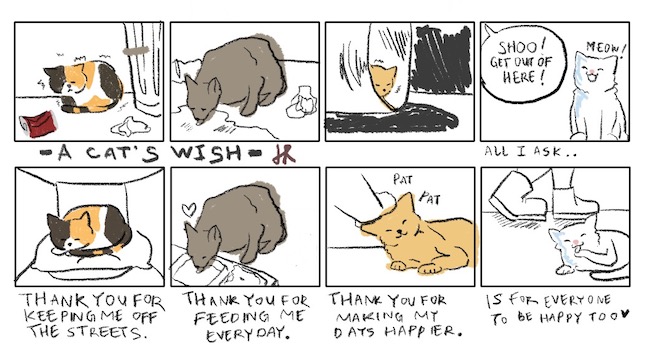Could you give a brief introduction to yourself and the club?
My name is Kyeong Seo Kim and I am a computer science major from [the Class of 2015]. I was active in two different clubs before, but I joined the KAIST Cat Shelter last spring semester because I was always interested in cats. [In 2018], we were recognized as an official club and I was elected president.
The main purpose of the club is to ensure the coexistence of cats and the members of KAIST. Our ultimate goal is protecting the rights of all animals on campus and advocating for the respectful treatment of all life.
The club was formed relatively recently; what has the club accomplished so far?
In 2017, there weren’t any official feeding spots for cats on campus, so they would cause problems while looking for food, such as ripping through trash bags or entering cafeterias. We set up some feeding spots with the aim of feeding them every day, and currently there are 10 spots. We also clean these areas often to avoid getting complaints.
Additionally, we are doing a Trap-Neuter-Return (TNR) project to control the increase of population. The project is funded by the school, the Yuseong District Office, and an outside organization. It has been shown that the program is most effective when 80% of the population has been neutered, and so far we have completed around 40% (34 cases). This semester we will try to get the other 40%.
There are some people who believe capturing and neutering cats to be unnecessary or upsetting. Why does the club believe it to be important to reduce the population of cats on campus?
Cats are a very territorial species and the school has a limited capacity. If there are more than a hundred cats on campus, they will be fighting constantly. The fights can become extremely loud, especially for the males.
Repeated pregnancies are dangerous for female cats. Male cats in heat are in pain when they cannot mate, so they mate whenever they can. The pregnancy period for cats is only around two months, so a cat that just gave birth could soon get pregnant again. A single cat can become pregnant three or four times, which is harmful to the uterus. Pyometra (uterus infection) has lethality rate of nearly 100% for cats. Repeated pregnancies cause lives to be shorter and more painful. For an unneutered feral cat, the life expectancy is less than one year, whereas one that is neutered has a life expectancy of three to four years.
I think a part of the concern is that we will return the neutered cats straight back into the wild without letting them recover first. We have personal relationships with the cats and truly care for their wellbeing; we make sure they are fully recovered before releasing.
Do you have any upcoming plans?
We want to go on and help all the animals on campus. Raising awareness through seminars or events is something we’d like to do.
However, maintaining the current activities is the focus for now. Both feeding and TNR have large costs and funds can run out quickly. For example, an outside organization that was supporting us finished its funding project.
How do you raise money?
Other than direct funding, we are also trying to raise money on our own. We had a booth selling cat-related goods and stickers. Recently we used fundraising website Tumblbug to sell calendars. All profits were used for the club, but it’s not enough to cover all the costs. At the moment, the club members are paying for the running costs. For people who love cats but are unable to join the club, we would appreciate donations to 3333-06-7635542 Kakaobank.
Some people on campus are allergic to cats and some simply dislike cats. Do you think everyone can coexist with the cat population?
Some people like cats but it’s also natural that some people dislike cats. We’re placing the feeding spots away from populated areas, but there’s only so much we can do to prevent such encounters.
The cats don’t actively harm us unless we harm them. When we see a cat, we shouldn’t provoke it, scream at it, or be violent. If we do, they’ll learn that humans are dangerous.
One of our members used to dislike cats because of allergies. But after living in the dorms and seeing that cats can be calm and cute, she began liking cats and joined the club. I hope more people can realize the therapeutic joys of cats, especially in a school that can be so stressful.


